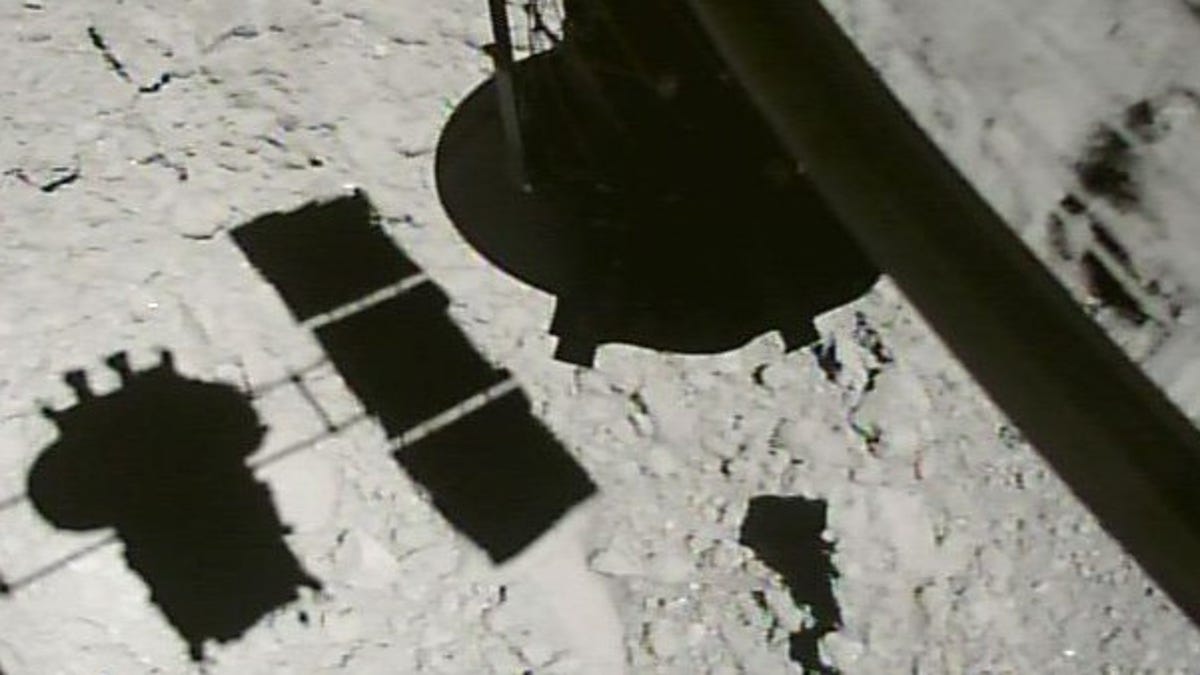Japan's Hayabusa2 spacecraft just completed a historic asteroid landing
The asteroid-chasing spacecraft pulled off another daring heist, scooping up samples from near-Earth asteroid Ryugu.

Hayabusa2 hovers above Ryugu as it drops a target marker on the surface.
Over a year ago, the Japanese space agency's Hayabusa2 spacecraft rendezvoused with Ryugu, a near-Earth asteroid shaped liked a diamond. Chasing the asteroid for the past year, Hayabusa2 has dropped hopping landers on its surface and nabbed a bucketful of rock after completing a daring touchdown. On Wednesday evening, the spacecraft performed a second touchdown maneuver -- scooping up important, new samples to bring back to Earth.
Hayabusa2 was equipped with a space cannon that fired a copper bullet into the surface of Ryugu in April, exposing some of the asteroid's subsurface rock. Ryugu is particularly rocky, meaning touchdown is a high-risk proposition. However, the scientific value of retrieving subsurface samples is considered high reward. As a result, Japan's space agency, JAXA, conducted intense investigations of the touchdown location to determine whether it was safe for its spacecraft to land and scoop up a sample of the freshly-exposed rock.
The mission is regarded as highly important because sampling the pristine subsurface rock could give us a greater understanding of the early solar system and how asteroids like this formed. In addition, it will inform the space agency's aspirations to travel to and sample other asteroids in the solar system.
"We would like to cover Mercury all the way to Jupiter," said Hitoshi Kuninaka, director general of Japan's Institute of Space and Astronautical Science (ISAS) prior to the mission. "For the future missions, Hayabusa2, the second touchdown, will play a very important role. It's a major pivotal point and a cornerstone."
During the mission, Hayabusa2 slowly approached Ryugu, getting closer and closer to the surface (and delivering a handful of incredible surface images). To ensure a safe touchdown, the spacecraft dropped a reflective marker onto the surface from a height of 9 feet in early June, which it uses to orient itself and descend autonomously -- without any manual help from mission control back in Japan.
At 5:56 p.m. PT, the spacecraft reached an altitude of 30 meters, at which point it captured the marker's location and began to track it. From this point on, Hayabusa2's movements were all left to the intrepid robotic flyer and it began to hover over Ryugu. Over the next 15 minutes, the spacecraft made a number of movements to descend to just 8.5 meters from the surface.
The final descent occurred, in front of a nervous JAXA mission control, at 6:19 p.m. PT and JAXA confirmed the touchdown appeared successful at 6:22 p.m. PT. Mission control cheered and clapped the success and based on real-time data streaming back from Hayabusa2, JAXA confirmed the spacecraft had started to rise back to a safe orbit after touchdown.
Mission control celebrating a touchdown.
A final confirmation of success required the spacecraft to point its antenna toward the Earth before JAXA could officially determine how the touchdown went -- and the green lights were seen at 6:53 p.m. PT, and the mission control erupted into applause yet again.
[PPTD] July 11 at 10:51 JST: Gate 5 check. The state of the spacecraft is normal and the touchdown sequence was performed as scheduled. Project Manager Tsuda has declared that the 2nd touchdown was a success!
— HAYABUSA2@JAXA (@haya2e_jaxa) July 11, 2019
"Everything has progressed quite smoothly and I am very happy," said Akira Fujiwara, honorary professor of ISAS, as the success was announced.
Hayabusa2's mission is not quite over yet. The spacecraft still has one more huge milestone on the horizon: releasing another lander onto Ryugu. The lander, known as MINERVA-II-2, carries ROVER-2, a small, lightweight robot equipped with a thermometer and cameras. It can also "hop" across the surface of the asteroid like a frog. Once the lander is deployed, Hayabusa2 will begin its return to Earth, flying past our planet and delivering the sample return capsule in December 2020. Provided all goes well, it may even retain enough fuel to fly to a second asteroid candidate and scope it out.

